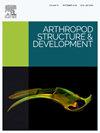An overview of campaniform sensilla arrangement and location on hexapod legs
IF 1.3
3区 农林科学
Q2 ENTOMOLOGY
引用次数: 0
Abstract
Campaniform sensilla (CS) are mechano-sensors in the cuticle of insects which are able to detect cuticle deformation. On insect legs, CS play a role in the modulation of locomotion behavior because they provide feedback on cuticle bending. The presence and location of these sensors on the legs across insects is virtually unknown except for a few classical model species such as Drosophila melanogaster (Diptera), Periplaneta americana (Blattodea), Carausius morosus (Phasmatodea) and a few others. We studied representatives of all insect orders, except Strepsiptera, regarding the morphology, location, and arrangement of CS on their legs to infer whether (i) CS location and arrangement is phylogenetically structured, (ii) there is any variation in CS morphology in relation to leg function, and (iii) CS morphology and arrangement is fundamentally different between holo- and hemimetabolous insects. We found enormous variation in all three aspects studied here - CS morphology, location, and arrangement - with no tangible phylogenetic structure or any distinction between holo- and hemimetabolous insects. Moreover, species from orders which are commonly considered to walk only for very short distances such as Odonata or Raphidioptera showed high quantities of CS on their legs compared to orders which are commonly considered to have “good” walking abilities such as Coleoptera or Diptera. We could also find putative CS on the coxa in Odonata, Dermaptera, Plecoptera, Orthoptera, Mantophasmatodea, Grylloblattodea, Embioptera, Blattodea, Hymenoptera, Raphidioptera, Neuroptera, Coleoptera, and Mecoptera which contradicts a common paradigm that CS occur only from the trochanter towards more distal leg segments. With its high variability, it appears that CS location and arrangement evolves according to the particular ecological and neurophysiological niche of each species with no phylogenetic constraints and a rather high adaptivity instead. Our study provides a baseline for future studies on CS function in insects with different ecological niches.
六足动物腿上钟形感受器的排列和位置综述
钟形感受器(CS)是昆虫角质层中的机械传感器,能够检测角质层的变形。在昆虫腿上,CS在运动行为的调节中起作用,因为它们提供角质层弯曲的反馈。除了一些经典的模式物种,如黑腹果蝇(双翅目)、美洲大蠊(扁蝽科)、墨背卡拉克(Phasmatodea)和其他一些物种外,这些传感器在昆虫腿上的存在和位置实际上是未知的。我们研究了除链翅目外的所有昆虫目的代表,关于CS在其腿上的形态、位置和排列,以推断(i) CS的位置和排列是否具有系统发育结构,(ii) CS的形态是否与腿部功能有关,以及(iii) CS的形态和排列在全代谢昆虫和半代谢昆虫之间存在根本差异。我们发现在这里研究的所有三个方面- CS形态,位置和排列-都有巨大的差异,没有明显的系统发育结构或全代谢和半代谢昆虫之间的任何区别。此外,与通常被认为具有“良好”行走能力的目(如鞘翅目或双翅目)相比,通常被认为只能行走很短距离的目(如蛇翅目或蛇翅目)的物种在腿上显示出大量的CS。我们还可以在翅翅目、皮翅目、翅翅目、直翅目、螳螂目、灰翅目、蜂翅目、蜂翅目、膜翅目、大翅目、神经翅目、鞘翅目和鞘翅目的髋部发现假定的棘突,这与通常认为棘突只发生在股骨粗端到更远的腿段的观点相矛盾。由于其高度的变异,CS的位置和排列似乎是根据每个物种特定的生态和神经生理位而进化的,没有系统发育的限制,具有较高的适应性。本研究为进一步研究不同生态位昆虫的CS功能提供了基础。
本文章由计算机程序翻译,如有差异,请以英文原文为准。
求助全文
约1分钟内获得全文
求助全文
来源期刊
CiteScore
3.50
自引率
10.00%
发文量
54
审稿时长
60 days
期刊介绍:
Arthropod Structure & Development is a Journal of Arthropod Structural Biology, Development, and Functional Morphology; it considers manuscripts that deal with micro- and neuroanatomy, development, biomechanics, organogenesis in particular under comparative and evolutionary aspects but not merely taxonomic papers. The aim of the journal is to publish papers in the areas of functional and comparative anatomy and development, with an emphasis on the role of cellular organization in organ function. The journal will also publish papers on organogenisis, embryonic and postembryonic development, and organ or tissue regeneration and repair. Manuscripts dealing with comparative and evolutionary aspects of microanatomy and development are encouraged.

 求助内容:
求助内容: 应助结果提醒方式:
应助结果提醒方式:


